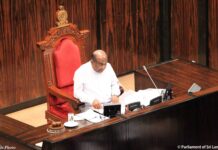Sri Lanka is expecting 32 billion US dollars in inflows from exports of goods and services and financial inflows and outflows of 27.6 billion US dollars leaving a 4.4 billion surplus to service debt, State Minister for Money and Capital Markets, Ajith Nivard Cabraal said.
“We can comfortably repay all the debt that is falling due. We are monitoring that carefully to ensure that they happen,” Minister Cabraal said.
Sri Lanka’s central bank Governor, W. D. Lakshman said there was 3.7 billion US dollars of net debt to be paid, after discounting dollar debt held by residents.
Inflows
Sri Lanka is targeting exports of 13 billion US dollars in exports in 2021 up from 10.7 billion dollars in 2020 when shipments dropped 15 amid a Coronavirus shutdown.
Strong growth is expected in boat building, minerals and gems. Sri Lanka exported about 300 million dollars in gems but most were getting re-exported out of Thailand which had 12 billion in exports, he said.
“We have removed export taxes it will be tax free. That will be a proper incentive we will have exports of around one billion dollars each year,” he also said.
A committee under Basil Rajapaksa, brother of President Gotabaya Rajapaksa, was working to help achieve export targets.
With a 2 rupee per dollar incentive for remittances, Sri Lanka is expecting 8.0 billion dollars in 2021 up from 7.1 billion dollars.
Services including tourism, shipping and information technology is expected to bring in 6.1 billion US dollars. Though Sri Lanka’s tourism receipts were 4.5 billion US dollars in 2018, only 1.5 billion dollars are expected in 2021, he also said.
In 2021, 2.5 billion US dollars of foreign direct investment was targeted.
A committee under Treasury Secretary, S. R. Attygalle was clearing impediments and fast-tracking the investments.
“If here are problem we will solve the problems,” Minister Cabraal said.
In addition to inflows into the Port City and industrial zone in Hambantota, there was strong interest in a pharmaceutical industrial zone in the area, he also said.
Outflows
Imports are expected to go up to 17.5 billion US dollars in 2021. FDIs will also trigger about a billion US dollars in imports. There are expected to be about 4 billion dollars in service outflows. About 1.4 billion US dollars are expected to flow out as dividends and returns on capital. Oil imports are expected to increase by billion dollars more in 2021, he said.
Outflows of around 27.6 billion dollars will leave 4.4 billion in excess allowing Sri Lanka to service the 3.7 billion dollars in debt owed to external parties. Domestic debt holders will be repaid in dollars. The numbers will be adjusted to take into account changes and ‘diligently’ reach the target. We will be more liberal or tighten it, he also added.
Sri Lanka recently tightened exporter repatriation rules and imposed surrender requirements on remittances and exports.
Treasury Secretary, S. R. Attygalle said many imports had already been liberalized.
Sri Lanka has controlled imports in a bid to ‘save foreign exchange’.
In 2020 Sri Lanka printed over 650 billion rupees and 2.3 billion dollars flowed out as debt repayments in the biggest balance of payments deficit in the island’s history, though credit was muted after April allowing imports to fall amid a lockdown.
In 2020, bond auctions are failing.
Analysts have warned that as long bond auctions fail and new money is injected into the banking system as rupee reserves, outflows will tend to outpace inflows and interventions in trade and the payment system will worsen regime uncertainty.
Under Sri Lanka’s soft-pegged monetary set up of injecting rupees when credit picks up to keep rates down, the credit system is vulnerable to currency pressure and balance of payments deficits, payment deficits.
Sri Lanka has also fixed oil retail prices which means total imports will not be crowded out through consumption and disposal income.
Instead the adjustment has to come through the credit system as the government cuts taxes and borrows more which may trigger more money printing as the yield curve is targeted with failed Treasuries auctions leading to forex losses.











